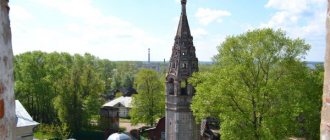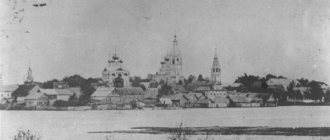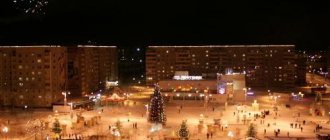Ostashkov
(Tver region)
OKATO code:
28440
Founded:
1587
City since:
1770 City of regional subordination
Center:
Ostashkovsky district
Telephone code (reference phone)
| 48235***** | — |
Deviation from Moscow time, hours:
0
Geographic latitude:
57°09′
Geographic longitude:
33°06′
Altitude above sea level, meters:
210 Sunrise and sunset times in the city of Ostashkov
How to get to Lake Seliger
The city of Ostashkov is considered the transport gateway to Seliger. The railway line connecting Bologoe with Polotsk passes through it. It is connected by highways with Tver, Rzhev, Valdai, Velikiye Luki, and Veliky Novgorod. A more difficult and longer journey lies ahead from Moscow and St. Petersburg.
You can get to Ostashkov without a transfer by buses from Tver, Moscow, Peno.
Buses from the Tver Bus Station depart daily and in large numbers - almost every half hour. Travel time is 3 hours 30 minutes. Arrival - at the Ostashkov Bus Station. The bus schedule for this route is available on the Tutu.ru website.
The ticket price is 500–680 rubles depending on the flight.
From Moscow, buses depart from the Northern Gateway bus station. There are a dozen flights daily - all arrive in Ostashkov before midnight. You will have to spend 6–7 hours on the road. Arrival at the city bus station. You can check the traffic schedule on Tutu.ru.
The ticket price is 880–1020 rubles depending on the flight.
From the urban village of Peno, minibuses run to Ostashkov three times a day. The trip will only take 40–50 minutes.
Ticket price: 147–160 rubles . Tickets are available at the local bus station ticket offices and on the Tver bus station website.
You can buy a ticket to Ostashkov from Tver and Moscow both before departure and in advance on the website Busfor.ru, which specializes in bus routes around the country.
There are also trains running to Ostashkov from the cities of Velikiye Luki and Bologoe.
A commuter train leaves from Velikiye Luki station at 8 a.m. (see schedule). The journey takes 5 hours 30 minutes. Ticket price: 540 rubles .
The train leaves Bologoe at 09:40 and goes to Ostashkov for 2 hours 50 minutes. But there is a much more interesting option - the Seliger retro train. A steam-powered train has been running between Bologii and Ostashkov since 2022.
Retro train "Seliger", © Sergio76
It departs from Bologoy station on Saturdays at 09:25. At the same time, the schedule is coordinated with the arrival of high-speed Sapsan trains from Moscow and St. Petersburg. At the Bologoye-Polotsk, Kuzhenkino, Batalino, and Ostashkov stations, original architectural ensembles have been preserved. While stationary at Kuzhenkino, a free tour of the station's museum complex is provided while the train is being filled with water.
The retro train travel time is 3 hours 30 minutes.
Train schedule Bologoe - Ostashkov 2022
If necessary, use the Yandex scoreboard. When you go to the service website, the traffic schedule for all days is available.
The cost of travel from Bologoe to Ostashkov on any train is 295 rubles .
At the Velikiye Luki and Bologoe railway stations there is a transfer when traveling from other cities. For example, by train from Veliky Novgorod to Bologoe, then by train to Ostashkov. You can get there from Moscow and St. Petersburg in the same way.
Local buses and minibuses depart from the Ostashkov bus station to settlements in the Lake Seliger area. The current public transport schedule can be found directly at the bus station.
A ferry runs between Gorodomlya Island and the Chaikin Bereg pier.
Ostashkov, © Alexander Smirnov
By car
The southern part of Lake Seliger is approached by highways 28K-1785 and 28N-1179. You can turn onto the first one near Torzhok, and the second one is laid from Rzhev. Route 28K-0001 approaches the lake from the southwest.
From Veliky Novgorod you can get to the village of Polnovo (northern bank of Seliger) along the E-105/M-10 highway. Near the village of Yazhelbitsy you need to turn off the road to the right, then at Demyansk - left. The second route lies further west. You must follow the P-56 road to Shimsk, then follow the 49K-15 to Staraya Russa and 49K-17 to Demyansk. Next, you need to choose the direction towards your final destination.
According to tourists, the roads surrounding the reservoir are in poor condition.
Seliger: video
Map
| Ostashkov: maps |
Ostashkov: photo from space (Google Maps) Ostashkov: photo from space (Microsoft Virtual Earth)
| Ostashkov. Nearest cities. Distances in km. on the map (in brackets along roads) + direction. Using the hyperlink in the distance , you can get the route (information courtesy of the AutoTransInfo website) | |||
| 1 | Foam | 32 (37) | SW |
| 2 | Selizharovo | 39 (47) | SE |
| 3 | Firovo | 51 () | NE |
| 4 | Marevo (Novgorod region) | 63 (100) | Z |
| 5 | Kuvshinovo | 65 (76) | IN |
| 6 | Demyansk (Novgorod region) | 66 (112) | NW |
| 7 | Andreapol | 75 (81) | SW |
| 8 | Ozerny | 87 () | NE |
| 9 | Valdai | 91 (195) | WITH |
| 10 | Bologoe | 99 (254) | NE |
| 11 | Vyshny Volochyok | 100 (200) | NE |
| 12 | Nelidovo | 105 (249) | YU |
| 13 | Olenino | 107 (203) | YU |
| 14 | Torzhok | 113 (126) | IN |
| 15 | Toropets | 114 (336) | SW |
| 16 | Hill | 115 (316) | IN |
| 17 | Western Dvina | 116 (293) | SW |
| 18 | Spirovo | 117 (180) | IN |
a brief description of
Located on the Valdai Hills, on a peninsula in the southern part of Lake Seliger (pier), 190 km west of Tver. Railway station.
Ostashkov is a tourism center on lakes Seliger and Verkhnevolzhskoye.
Territory (sq. km): 13
Information about the city of Ostashkov on the Russian Wikipedia site
Historical sketch
In 1371, in a letter from the Lithuanian prince Olgerd to Patriarch Philotheus, Klichen, the most outlying border town of the Moscow principality (in the northwestern part of the island of Klichen, 1 km from the modern city), is mentioned. In 1393, the Novgorod “eager army” ravaged and burned the city of Klichen.
Since 1434 (1477 ??) the Ostashkov villages have been known, on the site of which the Ostashkovskaya (later Iosifovskaya) and Timofeevskaya (later Metropolitan or Patriarchal) settlements arose. According to legend, they were called after the first settler fisherman Evstafy Ostashkovskaya or Ostashevskaya (Ostash, Ostashko - forms of the Orthodox name Evstafy).
In 1528, the hermit monk Nil settled on Stolbny Island, 10 km from Ostashkov. In 1594, Nilova Pustyn was founded on Stolbnoy Island, which later became one of the most visited and richest.
Around the settlements in 1587, due to the danger of a Lithuanian invasion, a fortress was built, called the Ostashkovo town.
In 1626 and 1651-53. New fortifications are being built. The fortress burned in 1676 and 1711 and has not been rebuilt since then.
In the 1760s. Ostashevskaya settlement in the Tver province of the Novgorod province. Since May 28, 1770, Ostashkov has been a city in the Novgorod province, since 1775 - a district town of the Tver governorship (since 1796 - Tver province).
A religious school was opened in Ostashkov in 1751, and a city school in 1772. A theater has been operating since 1805, and a library since 1883. In 1843, the first voluntary fire brigade in Russia was created.
From the end of the 18th century. Leatherworks are developing in the city (a tannery was founded in 1730).
In 1856, in the district town of Ostashkov, Tver province, there were 6 churches, 1360 houses, 205 shops.
Economy
Tannery, sewing software, meat processing plant, brewery and cheese factory, fish factory.
In the Ostashkovsky district, grain crops, flax, and potatoes are grown. Meat and dairy cattle breeding, pig breeding.
Main enterprises
LEATHER, FUR AND FOOTWEAR INDUSTRY
LLP "Ostashkovsky tannery"
172750, Tver region, Ostashkov, st.
Rabochaya, 60 Offers:
chrome leather, chrome yuft
Culture, science, education
Museum of Local Lore (since 1889).
10 km from the city in the village of Rogozha there is the Museum of Nature of the Seliger Region.
In 1669, Leonty Telyashin (L.F. Magnitsky), the author of the first Russian textbook on mathematics, was born in the settlement of Trestyanka (now Ostashkov).
Museums, galleries, exhibition halls
Museum of Nature of the Seliger Region 172747, Tver region, Ostashkov, Rogozha village, st.
Telmana, 18 Phone(s): (48235) 4-34-40 Website: https://tvermuzeum.ru/ Ostashkovsky Museum of Local Lore 172735, Tver region, Ostashkov, st. Volodarskogo, 19 Phone(s): (48235) 5-16-46
Architecture, sights
The city stretches along the running line of Lake Seliger. It was built according to a regular plan (drawn up by architect I.E. Starov), approved in 1772, drawn up taking into account the historical layout.
The silhouette of the city is largely determined by the ordinary buildings of the 18th - 19th centuries. and churches. Resurrection Cathedral (1689), Trinity Cathedral (1697), so-called. Town Hall House (1720).
The complex of the Znamensky Monastery (founded in 1673) with the Ascension Cathedral (1730-48). On the island of Zhitny, connected to the city in 1853 by a dam, there is a complex of the former Zhitny Monastery (founded in 1716) with the Smolensk Cathedral (1737-43) and the bell tower (1751), the gate church of St. John the Evangelist and St. Andrew the First-Called (1767-68 ), fraternal cells (1772-79 and 1861-63).
In 1785, the townspeople, in memory of the burnt fortress, installed the so-called fortress on the former city rampart. Valian pillar (chapel-obelisk).
The modern city is developing outside the peninsula.
| Population by year (thousands of inhabitants) | |||||||
| 1856 | 9.2 | 1979 | 24.4 | 2005 | 20.0 | 2014 | 17.1 |
| 1897 | 10.4 | 1989 | 27.4 | 2006 | 19.7 | 2015 | 16.8 |
| 1926 | 12.9 | 1992 | 26.8 | 2007 | 19.4 | 2016 | 16.6 |
| 1931 | 13.1 | 1996 | 23.5 | 2008 | 19.2 | 2017 | 16.3 |
| 1939 | 19.0 | 1998 | 23.1 | 2010 | 18.8 | 2018 | 16.0 |
| 1959 | 19.5 | 2000 | 22.1 | 2011 | 18.1 | 2019 | 15.7 |
| 1967 | 21 | 2001 | 21.7 | 2012 | 17.7 | 2020 | 15.4 |
| 1970 | 23.4 | 2003 | 20.7 | 2013 | 17.3 | 2021 | 15.2 |
Fishing in 2022
About three dozen species of fish are found in local lakes and streams, some of which are of commercial importance. On Seliger, stocking of fish is carried out periodically.
Fishermen claim that a good catch can be obtained with some skill and luck. You need to take into account weather conditions and the season, and also be able to determine where fish accumulate. The most common are perch, bream, silver bream, pike, rudd, pike perch, vendace, carp, etc.
Winter fishing on Seliger has its own characteristics and advantages.
The expanses of Seliger, © Nikolay Yushnikov
Between Tver and Novgorod
Lake Seliger is divided between two regions - Novgorod and Tver. The largest settlement is the city of Ostashkov. It is located on the southern coast. From Moscow to Ostashkov - 370 kilometers, from St. Petersburg - 470, from Tver - 190. Roads to the lake lead from both the Tver and Novgorod regions. Seliger has ideal transport accessibility.
The map clearly shows that Seliger is not one lake, but a system of lakes connected by channels. Many of them have their own names. This situation is common in Karelia. The similarity is easy to explain. Like most Karelian lakes, Seliger is of glacial origin. Hence its unusual branched shape. It seems that this is not a lake at all, but river meanders - smooth bends of the channel.
Sunset over Seliger
The total area of the water surface is 260 square kilometers. The coastline is so indented that its total length reaches more than 500 kilometers - a huge distance! The lake feeds more than a hundred rivers, rivulets and streams. But only one flows out - Selizharovka. There are many islands in Seliger, including quite large ones. The largest is Khachin.
There are about a dozen reaches – this is the name given to the deepest parts of the reservoir. There are Ostashkovsky, Berezovy, Selizharovsky and other reaches. The water in the lake is crystal clear. Transparency reaches five meters. You can verify this by throwing a coin into the water and following it with your gaze. Picturesque capes and deep bays delight the eye.









